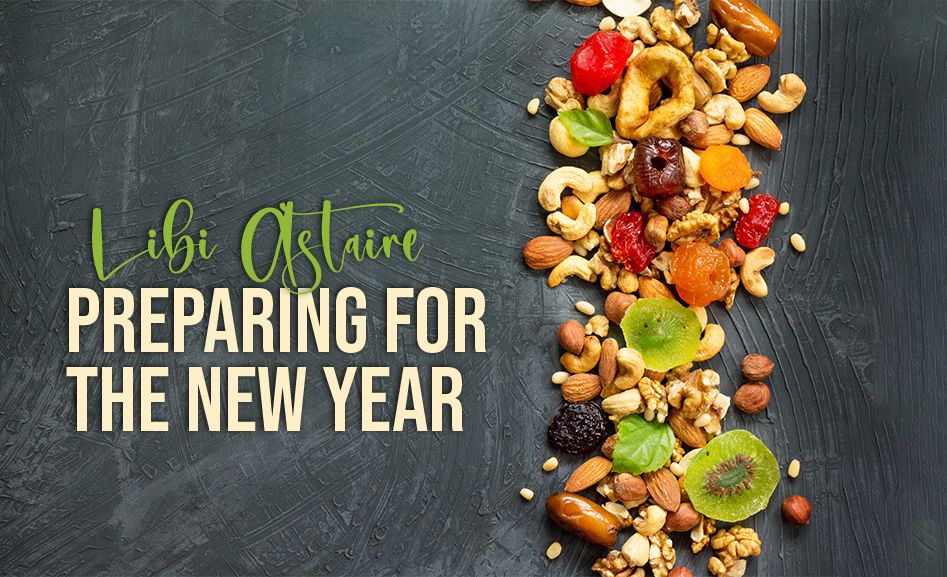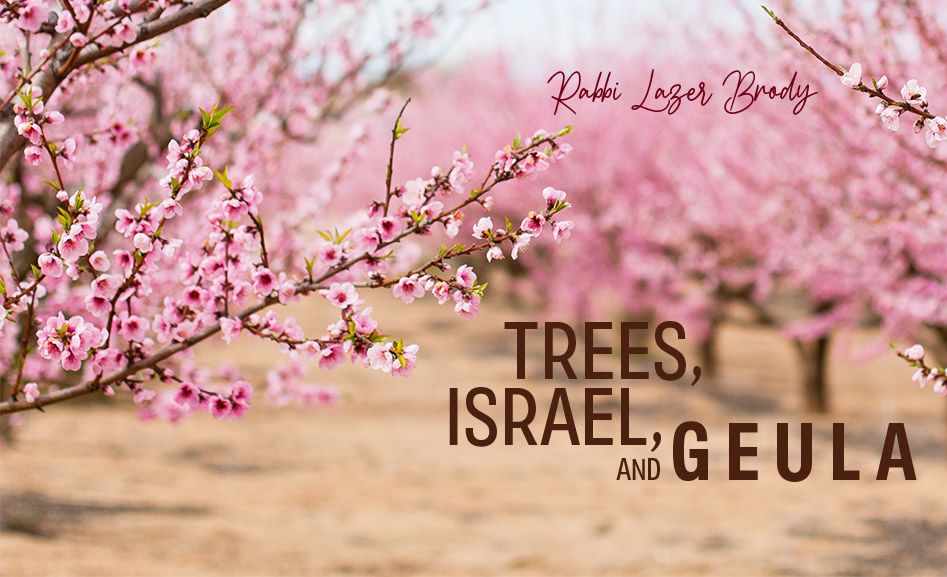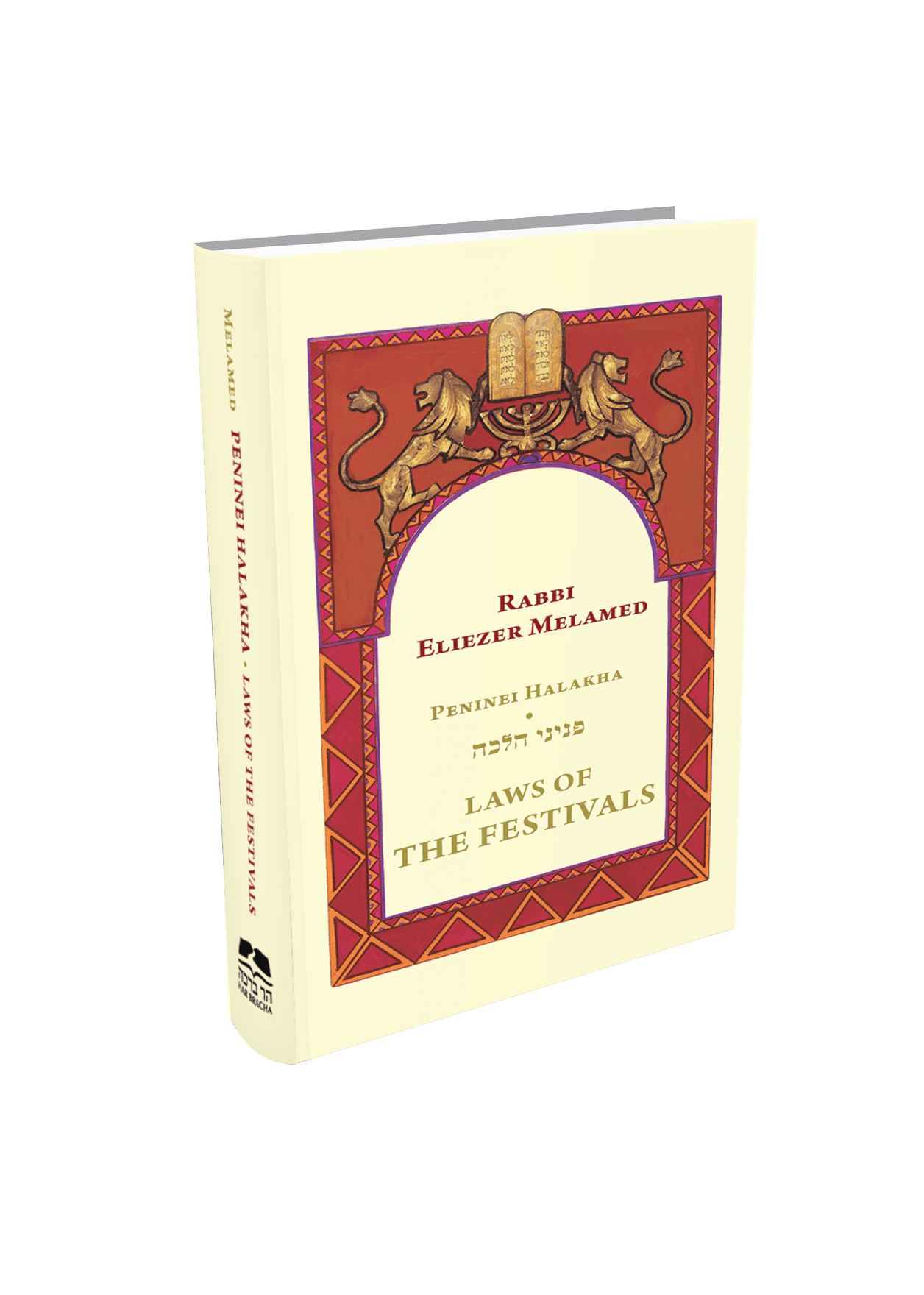
Tu B’Shvat: The Tree of Life
The tree is a good image to use in a discussion of spiritual growth, especially in the holiday of Tu B'Shvat — the Festival of Trees.

“Happy is the man . . . who delights in the Torah of God, and in his Torah he meditates day and night. He will be like a tree planted by rivers of water, that brings forth his fruit in season; his leaf shall not wither, and in whatever he does he shall prosper” (Tehillim 1).
The Symbol of the Tree
The image of the tree is a central archetype in human thought. Trees symbolize structure amidst diversity, the conscious and unconscious mind. Family lineage is charted on “trees.” Information is mapped out on trees. Trees depict species’ relationships, language development, the flow of a computer program. We commonly speak of “finding our roots”, of “bending with the wind”, of “turning over a new leaf”. In Judaism, as well, trees are a central image. The very first chapter of Bereishit tells us: “And the Lord God planted a garden eastward of Eden . . . And out of the ground the Lord God made grow every tree that is pleasant to the sight, and good for food…” (Bereishit 2:9).
There is the Tree of Knowledge of Good and Evil, representing all earthly wisdom, with its dual potential to either elevate human life and make of this world a paradise or to bring about mass destruction. There is the Tree of Life, representing spiritual enlightenment and the eternal life that comes from attachment to God, the Source of all being.
The tree also symbolizes the relationship between heaven and earth. But in this case, the “roots” of reality are above, united in God. In this world, we only perceive the branches and leaves — the illusion of duality. Kabbalah speaks of the Tree of the Sefirot, a mystical diagram delineating the various stages of emanations in the descent from God to man. The Torah even compares man to a tree. “Man is a tree of the field,” says the verse (Devarim 20:19). Like a tree, a man must be firmly rooted in this world, yet at all times reach upward to God.
Thus, the tree is an appropriate image to use in a discussion of spiritual growth, especially as we are approaching the holiday of Tu b’Shvat — the Festival of Trees.
The Baal Shem Tov taught that all growth involves three essential stages: hachnah, havdalah, and hamtakah — humility, discrimination, and conciliation. They can be found in the life of the soul, and in the life of a tree.
The Seed
The first step in the formation of a tree is the seed. The greatest Redwood begins from a kernel that you can fit in the palm of your hand. Yet within this seed is the entire genetic makeup of the tree. It is a point of absolute potency. Everything is contained in this seed, and only time and circumstance will determine exactly how that potential will be realized.
The same is true of spiritual growth. It begins as a seed: a thought, a word, a teaching from an enlightened master. It touches one’s heart and plants itself in the deepest realms of one’s subconscious. Slowly it develops, pushing itself into the light of one’s conscious awareness. The seed may be a rare moment of insight, a “peak experience” in which we suddenly realize who we are and what our truest goals in life should be. It can come from a walk along a beach, a visit to the Kotel, or a blessing recited over the Shabbat candles. It may come in a moment of true silence in which we hear our innermost voice. There are individuals who returned to Torah because a particularly beautiful Chassidic melody touched them so deeply that it set them on a path of searching that led to God. In any event, we intuitively understand that this seed contains within it all the answers that we are looking for. It is so powerful, so engaging that we may pursue the vision the rest of our lives. If we do not, we will never be satisfied, for we will always be avoiding our truest calling. The Talmud teaches that this seed is planted in every individual while they are still in the womb. At the moment of birthgrowth it is forgotten, yet a faint memory remains. Our job in life is to search and reclaim that vision to the fullest possible extent.
However, in the initial stage, the seed is only one component in the process. The other equally important factor is the ground. Before any seed can be planted, the ground must be prepared; it must be softened and broken up. If not, the seed will never take root; it will only dry up upon the surface and never develop at all.
In the process of spiritual growth, the first step is always preparing the ground, which means cultivating a readiness to change. We must recognize the point of truth when we encounter it, and be prepared to turn over our lives so as not to miss the opportunity. Malachim, the Book of Kings, tells a beautiful story of the first meeting of Eliyahu Hanavi (Elijah the Prophet) with his disciple, Elisha. God send Eliyahu to appoint Elisha as his successor:
“And he found Elisha, the son of Shapat, who was plowing with twelve yoke of oxen before him, and he was with the twelfth. And Eliyahu passed by, and threw his mantle upon him. And he left the oxen, and ran after Eliyahu and said, Let me, I pray you, kiss my father and my mother, and then I will follow you. And he said to him, go back, what have I done to you? And he returned back, and took a yoke of oxen, and slew them and boiled their meat with the instruments of the oxen, and gave it to the people and they ate. Then he arose, and went after Eliyahu, and ministered to him” (Malachim I, 19:19-21).
Kabbalah compares the underlying nature of the human mind to a vast field, in itself empty, yet immensely fertile with the power of growth. The mind must generate produce. The various thoughts and ideas that flit through our consciousness during the day can be compared to weeds that spring up spontaneously. However, the mind can be worked, it can be prepared to receive the seeds of true wisdom. Eliyahu found Elisha plowing; he was preparing his field. Likewise, the Talmud says that a person must make his ears like plowed earth, and accept all the words of the sages. Only when we are aware of how little we truly know, are we prepared to receive knowledge and experience beyond our present level.
Thus, the initial step in spiritual growth is hachnah, which means humility and submission. We must put aside our preconceptions of what the Torah is going to tell us and let it speak for itself. The more we can free ourselves from the ego bonds that influence our every action and opinion, the more we can receive a greater truth. Reb Nosson of Breslov, the chief disciple of Rebbe Nachman, claimed that he achieved more than the Rebbe’s other followers only because he put aside his own understanding of reality and accepted the enlightened consciousness of his master.
Submission does not mean becoming a mindless cult follower, God forbid. It does not mean ceasing to raise questions and ignoring our intellectual and emotional faculties. It does mean putting aside the part of ourselves that pretends to have all the answers, thereby dismissing the possibility of future growth. It means recognizing our present limitations and allowing the Torah to transform us. At every stage of personal growth, Judaism encourages questions. However, questions must be asked from a heart willing to change, not merely challenge. There must be the readiness to grow when we hear genuine answers.
This is the most elementary level of hachnah. At the other extreme, there is a level of submission so high that one touches the very core of existence. If we were able to put aside ourselves — our opinions, our desires, our attitudes, our very identities — we could become a completely clear vessel for God. The Talmud identifies Moshe (Moses) as having achieved a level of prophecy qualitatively higher than all subsequent prophets — he saw God through a “clear lens” — because he was able to transcend his personality entirely; thus his vision of divinity was untainted.
Rabbi Adin Steinsaltz writes of this highest level of submission:
“In order for man to be a repository for Divine Light, he has to completely nullify what he is. So long as he persists in being himself, he cannot be a Divine instrument or likeness, because he is of a different essence. By nullifying himself he can shatter the limitations of his being and let the Divine Light pour into his soul. To reach the love of God, man has to get rid of love of himself; so long as he clings to his three-penny possessions there is no room for anything else.“Consequently, too, the prophet is not a man like other men — not because he is a mad or extraordinary person, but because he has thrown off his self-hood and become an empty vessel. He has become a vessel that God can fill and use. Moshe was the greatest of prophets, able to speak with God because he was the humblest of men on earth. Because he had become nothing in his conscious existence, his existence could serve the Shechinah (the Divine Presence) properly” (In the Beginning).
The relationship of seed to ground is part of the very fabric of creation. The Torah alludes to it in the verse, “And it was evening, and it was morning . . .” (Bereishit 1:5). All creation begins with darkness — the lack of light, the willingness to accept. God beholds this receptivity and emanates the light of creation. All the trials and difficulties we experience on the path to truth may only be God’s way of “preparing the ground.” Sometimes, God must literally break up our lives in order to bring us back to Him. Many people turn to spirituality out of a deep dissatisfaction with life; an emptiness eats away at them inside, giving them no rest. But it is precisely this pain that makes them receptive. When they hear the truth, they are ready to follow it.
We can also consciously prepare ourselves for spiritual growth. This entails accepting a spiritual pathway and committing ourselves to a practice. We must step willfully into that moment of submission, despite the fear of loss of self. Once inside, we are guaranteed to begin feeling at least the seed of truth.
The Tree
When the seed has taken root, the tree begins to grow. The development of a tree is an extremely long and detailed process. If a tree is to stand for years, and not merely a season, it must be strong and well rooted. The same is true of a spiritual path. A person searching for a genuine spiritual path, must choose one that has stood the test of time, and not some hybrid that has sprung up overnight. The next step, after having accepted the seed and opened oneself to a higher truth, is the slow, arduous task of learning the tradition.
The Baal Shem Tov calls this step havdalah, which means separation or distinction. Just as the cells of a tree divide, some forming roots, others branches, others leaves, so the student of the Torah must slowly learn the various divisions of Torah. One must trace its roots in history, must grasp the body of its principles, the over-arching concern of its laws. The student must learn the Torah in all of its complexity. This is especially true in matters of Jewish law, where a hair’s breadth difference often stands between the permissible and the forbidden.
Studying the “tree” of Torah is a lifelong occupation, and no one can master it all. The Talmud tells the story of Rabbi Eliezer the Great, one of the leading sages of his time, who exclaimed on his death bed, “I learned a great deal of Torah from my teachers, but it amounted to no more than a dog lapping water from the ocean.”
Grasping the tradition is a daunting task, and often terribly frustrating for beginners. But eventually it is an extremely fulfilling experience. The Torah is a tree of utmost beauty and perfection. The various branches are exquisitely interwoven. Each law, story, or metaphor conveys incredible depth and wisdom. Every word bears the stamp of Divine inspiration, and all of it serves to edify both the individual and society. Slowly, slowly, one gets a complete picture and a sense of the truest meaning in life. Above all, the more one studies Torah, the more one finds one’s own particular niche. Some individuals love Halacha, some Midrash, some Kabbalah. Every soul is connected to a different branch of the Torah. And every person, depending upon his or her inclination, can find in it personal meaning. And this brings us to the last step in the growth of the tree.
The Fruit
When the tree is mature, when the roots have gone deep and the branches filled with leaves, it brings forth fruit — sweet to the palate, beautiful to behold, and rich with the seeds of future growth. The same is true of the tradition. An individual who has committed himself to the tradition, toiled at it, cried over it, struggled to master its beauty, can then begin to put forth fruits, his own insights and ideas. Even though one’s tree may not yet be tall or broad, each person can add his or her own chidushim (original thoughts) to the Torah. The Baal Shem Tov called this state hamtakah, which literally means sweetening, because the complex, and at times alienating, structure of the Torah is internalized and personalized. The words of Torah speak to one’s heart, and issue out from the heart. They become sweet to us. When, to the best of our ability, we can become a living Torah, then the Torah bears fruit in our thoughts, our speech and our actions.
This is the relationship of the Written Torah to the Oral Torah. It is well known that when God revealed the Torah at Mount Sinai, He gave Moshe not only the Ten Commandments, but all the 613 mitzvot that are found in the Pentateuch today. Beyond this, an entire oral tradition was delivered as well. This contained all the details needed for a full understanding of the Written Law. This tradition was passed down orally for generations, as a sort of verbal commentary on the Pentateuch. At a certain point in history, this oral law was itself codified and committed to writing in the Mishnah, the Talmud and the Midrash. However, whereas the Written Torah is God’s unalterable message to humanity, transcribed once and for all by Moshe in the highest state of prophecy, the Oral Torah has never ceased being written, for it is man’s response to God. It is comprised of all the insights and novella born out of the hearts of the Jewish People as they strive to understand and internalize the words of the Living God. The Oral Torah is an extension of the Written Torah.
The Written Torah is made up of the words of the Infinite God, thus it has within it the potential for infinite meaning. Answers to even the most contemporary scientific and philosophical issues can be found in the Torah. It is through deep investigation into the words of the Written Torah that new insights are gained. The interplay of written and oral tradition has allowed the Torah to speak with fresh meaning to every generation for over three thousand years. In this sense, the Written Torah is like a tree with many branches, reaching out to cover all aspects of life. The body of the tree remains from year to year. Whereas the Oral Torah is like the fruit, the endless new insights and interpretations of each season, and every individual.
The giving of the Torah occurred only once. But from that moment on, God invested the Jewish people with the power to continue and expand upon His word. The Torah is “not in heaven,” says the Talmud. It has been transmitted to the Sages of Israel and to true spiritual seekers for all generations.
The Talmud comments on the verse from Tehillim: “Happy is the man . . . who delights in the Torah of God, and in his Torah he meditates day and night.” At first, declares the Talmud, it is called the Torah of God. But after a person toils at it, it becomes his [meaning, the person’s] Torah.” If a person invests his life in Torah, the Torah speaks through him. “He will be like a tree that brings forth fruit in its season; his leaf shall not wither and in whatever he does he will prosper.”
When an individual reaches this level, then the very elements of his personality that had originally obscured the quest for truth now become the avenues of its revelation. Kabbalah teaches that every aspect of creation exists only to reveal the presence of God. But in order to do this, it must first be purified of its base and selfish elements. Likewise, when the individual has purified himself through hachnah and havdalah, and has reached the stage of hamtakah, the personality itself becomes a vessel of revelation, providing the very qualities necessary for the individual to originate new ideas, and add to the Oral Torah.
Devarim begins with these words: “These are the words which Moshe spoke to all Israel on this side of the Jordan in the wilderness . . .” (Devarim 1:1). Of all the Five Books of the Torah, Devarim is unique. Whereas the first four books are the words of God, dictated to Moshe, Devarim contains the words of Moshe himself – his thoughts, hopes and admonitions to the people of Israel. Yet, these words are as much a part of the Torah as the first four books. This is because after forty years of making himself a complete vessel for the revelation of the Almighty, Moshe’s words became Godly. Moshe, who achieved the greatest level of hachnah, now achieved the greatest level of hamtakah, as the words of his own heart were inscribed for all time together with God’s.
The Midrash comments on this first verse of Devarim: “The same mouth that originally said, ‘I am not a man of words’ (Shemot 4:10), now said, ‘These are the words of Moshe.'” When God first spoke to Moshe at the Burning Bush, Moshe claimed that he could not deliver the people of Israel because, “I am not a man of words.” That is, he realized that he had nothing of his own to say. But this is precisely what God wanted. Moshe’s complete humility made him the perfect vessel. “I will be with your mouth, and teach you what to say,” answered God (Shemot 4:12). However, at the end of forty years of transmitting God’s words, Moshe spoke for himself, and his own words, his own Torah, was holy.
It is known that the Jewish holidays are not merely commemorations of past events. They are recurring points in time invested with great powers of transformation.
In the middle of the Hebrew month of Shvat, there is a minor holiday known as Tu b’Shvat, literally, the “Fifteenth of Shvat.” The Talmud identifies this day as the New Year for trees. The date is important in regards to the Torah’s agricultural laws, which require produce to be tithed annually for distribution among the priestly class and the poor. Tu b’Shvat distinguishes between the old and new crop, and begins a new cycle of tithes.
On the spiritual level, Tu b’Shvat is the new year for our latent power of creativity. The Talmud states that on Tu b’Shvat, the sap begins to rise in the trees. This is the first step in the development of the fruit. On this day, each person can begin to discover new insights into his own spiritual practice. Although we outlined three steps, above, hachnah, havdalah and hamtakah, they are not mutually exclusive. All three can occur simultaneously. In one area of life, a person may be still learning. In another, he may already be able to generate new ideas. The process may also move in long or short cycles, and a person can pass through all three stages in a single day.
The opening verses of Devarim continue: “In the fortieth year, in the eleventh month, on the first day of the month, Moshe spoke to the children of Israel, according to all that the Lord had given him to command them” (Devarim 1:3). Moshe began his personal exposition of the Torah in the eleventh month — the month of Shvat, because this is the power of the entire month of Shvat, to open our hearts to the Torah that is deep within us.
“Man is a tree of the field.” When a person can accept the seed of the inspiration and water it with true commitment to the tradition, eventually, the Torah will bear fruit in his life. One’s own words will be an outgrowth of the tradition. And one’s own insights will contain seeds of inspiration for the lives of many others.
The path of Torah is a path of wholeness and integration. It so aligns us with the deepest currents of creation that we become transformed. The Torah becomes ours, and we become holy. “It is a Tree of Life for those who cling to it, and happy are those who support it” (Mishlei 3:18).












Tell us what you think!
Thank you for your comment!
It will be published after approval by the Editor.